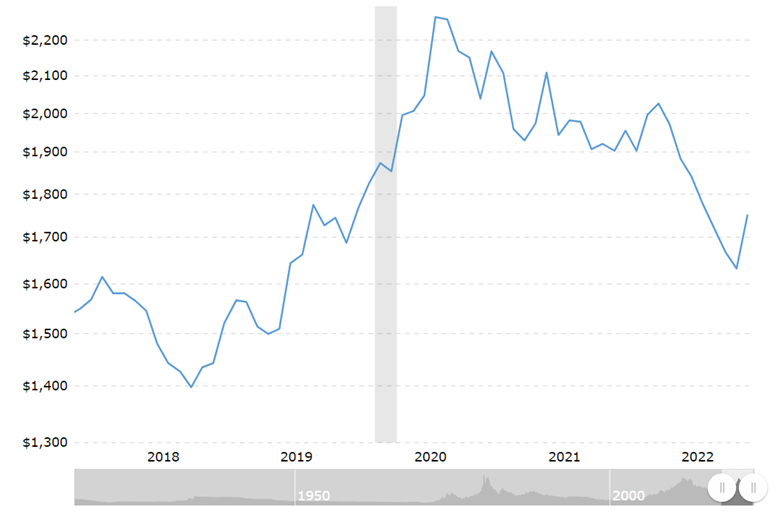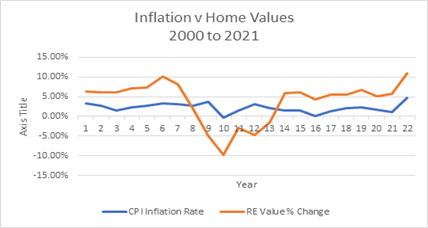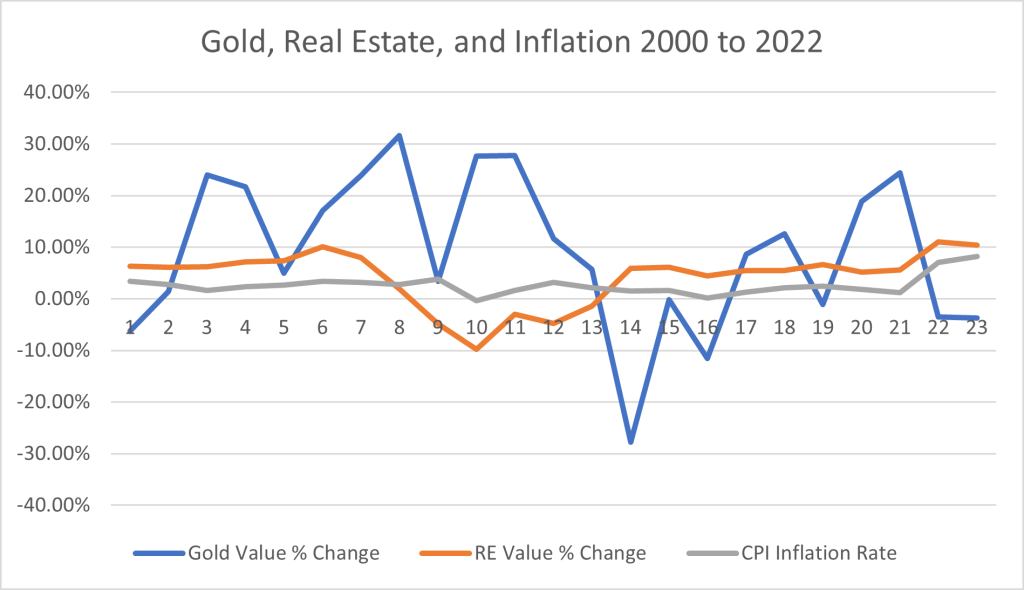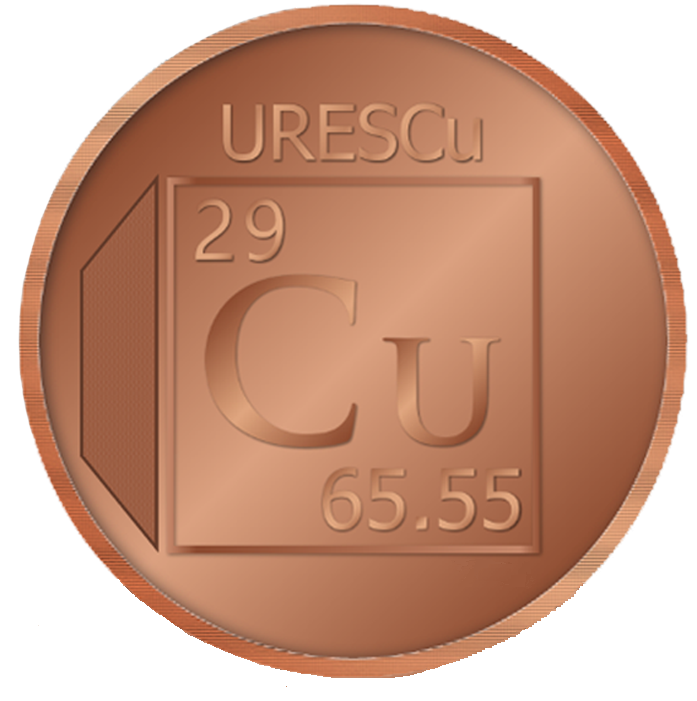
Protecting Your Wealth with Gold, Silver, or CuBit™
Protecting your wealth with gold, silver, or CuBit™ is an important topic. As we talk with people about protecting their wealth from inflation and volatility with CuBit™, many people ask about using gold or silver instead. This article discusses and compares the merits of all three as vehicles to protect your wealth from inflation and volatility.
Gold, silver, and CuBit™ are all promoted as vehicles to protect your wealth against inflation. Unfortunately, gold and silver values are often volatile. CuBit™, in contrast is designed to have extremely low volatility.
The following chart shows the price of gold since 1915 (see Figure 1). While the general upward trend clearly demonstrates the value of gold as a hedge against inflation, the frequent and extreme changes, up and down, are the very definition of volatility.

Figure 1 Gold Prices – 100 Year Historical Chart

Figure 2 Gold Prices Over the Last 5 Years
Source: Macrotrends, 11/11/2022, Gold Prices – 100 Year Historical Chart, https://www.macrotrends.net/1333/historical-gold-prices-100-year-chart
A view of the last five years (see Figure 2), from this same source, clearly demonstrates the ongoing volatility of gold prices.
Over the last five years the value of one Troy Ounce of gold has varied from a low of $1,400 to a high of $2,267 and back down to the current price of $1,752.
Volatile Gold
The market value of gold is driven by supply, demand, and speculation.
Supply and Demand
Investopedia[1] notes the simple fact that “When gold miners produce an excess of gold relative to demand, the price will experience downward pressure due to the laws of economics.”
While experts estimate that the world’s supply of gold has historically grown an average of 2% per year, a portion of that supply is taken out of circulation for use in semiconductors, jewelry, art, lost, or destroyed in accidents. Presumably, what remains in circulation is held by governments and private collectors (collectors include the companies selling gold certificates, et al).
Speculation
The same Investopedia article[1] notes that “Investors speculate as to what governments and central banks are going to do and then act accordingly.” In other words, if they think their wealth will grow faster through stocks or other investments, they sell gold, bringing its price down. In contrast, if they believe other investments are going to drop in value, they buy gold, driving the price up.
Silver Sadness
Like gold, silver supplies are decreased by their use in semiconductors, jewelry, art, lost, or destroyed in accidents. However, while some tout the desirability of silver right along with gold as a hedge against inflation, the facts show that silver and gold have very different stories.
A chart [6] showing the price of silver over the last 100 years (see Figure 3) unsurprisingly shows the volatility of silver. However, it also reveals that silver doesn’t do well as a hedge against inflation. The overall trendline of silver is essentially flat. Its value is nearly the same today as it was in 1919.
This overall flat trend means that a $20 bill in 1919 would buy you the same ounce of silver then as today. Unfortunately, in all other regards since 1919 the $20 bill has lost more than 60% of its buying power for everything else.
Some will look at the spike in silver prices to nearly $140 in February of 1980 and hold out hope for higher silver prices. However, this spike is a classic example of speculator manipulation of the market.
The Silver Institute [2] notes that, in 1979 and 1980, two brothers attempted to ‘corner’ the silver market. The Hunt brothers hoped to buy up all available silver supplies. Then they could control the supply and force the price higher. They failed and silver prices plummeted.

Figure 3 Silver Prices Over the Last 100 Years
Source: Macrotrends, 11/11/2022, Silver Prices – 100 Year Historical Chart, https://www.macrotrends.net/1470/historical-silver-prices-100-year-chart
Translation: Silver doesn’t hedge against inflation, and it is volatile. Those two strikes make it less attractive than fiat currency. Accordingly, we will dismiss it from further discussion as an viable alternative to gold or CuBit™.
Certificates Aren’t Precious Metal
Before considering the relative merits of investing in gold or CuBit™ it is important to make some distinctions between buying something inherently valuable versus buying something that represents something inherently valuable.
Buying gold futures contracts, securities, funds, and notes are not the same as buying gold. Many people buy precious metals this way for convenience. Gold is heavy, bulky, and has no immutable indicators of ownership. This last point means that if it is stolen and then found, you can’t undeniably prove it is yours. That’s why people want to steal it, and why many people buy certificates instead of holding gold directly.
Buying certificates redeemable for gold or holding them in an account with some firm is not the same as buying gold and silver. Certificates are receipt currency. Receipt currency asserts that the paper is redeemable for a specific amount of gold or silver. The true value of receipt currency depends upon the reserves of metal kept for redemption.
Fractional Reserves
If the reserves of metal are not greater than or equal to the sum of all the certificates, then the depository is keeping “fractional reserves.” In other words, the quantity and value of the metal kept on hand is less than 100%, a fraction, of the value stated on the certificates. This means that if all the certificates were presented for redemption at the same time, some people would not get their full value.
Fractional reserves mean that the certificate, or account balance, is worth less than the face amount of the account. Unfortunately, fractional reserves are common practice. Sellers of gold certificates may tout how much gold they have in their vault, but that is meaningless until you know how much gold they have issued in receipts.
Custody
When you use receipt currency, someone else has custody of your asset. Your purchase is kept in some else’s safe keeping.
When you hold gold or silver in your hands, be it ingots or coins, you are holding something inherently valuable. When you own a piece of land, you own something inherently valuable.
When you have custody of your own assets, the burden is on you to keep them safe from hazards such as fire or theft. The burden is also on you to exchange your asset for currency you can use to purchase goods and services, or directly for goods and services.
Survivalist Gold
The point of discussing custody is to ensure that you understand that holding a gold certificate is neither more, nor less valuable than holding stock in a company. It will only protect your wealth while the economy continues to function. If the economy collapses, your gold certificates are worthless paper. In the collapsing economy scenario, gold in hand may be valuable.
Of course, when survival is on the line, the only real items of value are shelter, food, clothing, and physical protection. Gold doesn’t meet any of those criteria, and it weighs a lot more than most of those things that do meet the survival criteria.
CuBit™ and Real Estate
The essential value proposition of CuBit™ currency is that it uses real estate to protect your wealth against inflation and volatility. Approximately 65% of the value of CuBit™ is backed by real estate. To meet your liquidity needs and reduce risks, the other 35% of the value of CuBit™ is backed by cash reserves (liquid assets).
Throughout the history of the USA real estate has proven an effective hedge against both inflation and volatility.
Real Estate Volatility
The local nature of real estate values, the size of the USA, as well as the economic strength and mobility of the middle class combine to create a very fragmented real estate market. This fragmentation is a wonderful, systemic, mechanism that has a proven track record of isolating real estate busts and booms to specific areas of the country. Often, these bubbles (and their bursting) are restricted to a single metropolitan area.
A recent, and extreme, example shows how this fragmented market serves to insulate the overall market from volatility.
In late 2022 Hurricane Ian destroyed parts of the Gulf Coast of Florida. This crushed the value of destroyed properties. While news reports showed some investors rushing into the area to buy up the devastated real estate at very low prices, value elsewhere in Florida were largely unaffected.
Real Estate and Inflation
The following chart shows the 20+ year track record of real estate value appreciation versus inflation (see Figure 4). While this chart illustrates the year-over-year changes, it doesn’t show the compounding effects of these incremental changes over time.

Figure 4 Inflation v Home Values 2000 to 2021
When you overlay the changes in the value of gold, the value of real estate, and the rate of inflation over the period from 2000 to 2022 (see Figure 5) the startling volatility of gold becomes obvious.

Figure 5 Gold, Real Estate, and Inflation 2000 to 2022

Figure 6 Gold, CuBit™ and Fiat Face Values from 2000 to 2022
The following chart (see Figure 6) compares the face value (without adjusting for inflation) of $100 of gold and $100 of CuBit™ as they change using the growth of gold and real estate from 2000 to 2022. Gold undeniably comes out ahead by ending the cycle at $646 versus $196 for CuBit™. However, the volatility of gold is clearly substantial. Dropping from $610 to $389 during the recession of 2012 to 2015. Many people get shaken when they see their wealth decline by 36% in just three years. In contrast, during that same period, real estate increased in value by 12%. If CuBit™ had been available then, those gains would likely have been realized for the wealth deposited in CuBit™.
In short, if you don’t mind some frequent white-knuckle drops in value, gold is good for growing your wealth. If your nerves can’t handle that volatility, CuBit™ is a very reliable alternative.
To see the compounding effects of having your money deposited in an inflation beating vehicle like CuBit™, we need to look at how $100 in a real estate vehicle retains and increases its buying power compared to keeping that $100 in your wallet (see Figure 7).

Figure 7 USD Inflation v CuBit™ Buying Power (projected) Over Time ($93 CuBit™ v $100 USD
Other Considerations
Although inflation and volatility are significant threats to your wealth, there are other threats and issues you should also consider.
Portability
Gold is portable, but heavy. In large quantities it quickly becomes almost impossibly heavy to move without special equipment.
Regardless of the amount of CuBit™ you have, it can all fit on a single jump drive.
Theft
As mentioned previously, gold has no immutable marker to show it belongs to you. This makes it a prime target for thieves.
Because CuBit™ is a cryptocurrency it is stored in digital form and encrypted. When you store your CuBit™ in a secure, self-custody, crypto wallet no one can get at it without the information only you have. Stealing the jump drive from your pocket is useless without also having the information needed to unencrypt the wallet. This makes CuBit™ very unattractive to thieves.
Usability
Gold isn’t accepted as currency. Although you might be able to exchange it in trade, if it isn’t in small coins it is going to be difficult to use for any commerce.
Although CuBit™ is new to the market, it seems like everyday there is another company offering to link a debit card to your cryptocurrency deposits. We expect it won’t be long until that is true for CuBit™. Then, CuBit™ will be easy to use for commerce. Until then, it can be electronically exchanged for a variety of fiat currencies which can be used for commerce. Also, it has denominations that can be very small, making it usable for the most mundane of purchases.
Conclusions
Silver doesn’t protect your wealth from inflation or volatility.
Investing in gold certificates is very risky. Choose tangible gold over certificates.
Gold does a great job of protecting your wealth from inflation. However, its volatility can be terrifying. In large quantities it isn’t very portable. It isn’t very usable for commerce, and it is hard to protect from thieves.
CuBit™ does an excellent job of protecting your wealth against both inflation and volatility. When you consider the additional factors of ease of portability, usability, and theft resistance, CuBit™ is clearly the best way to protect your wealth.
Endnotes
[1] McFarlane, Greg. 22 April 2021, When and Why Do Gold Prices Plummet, https://www.investopedia.com/articles/investing/071414/when-and-why-do-gold-prices-plummet.asp
[2] The Silver Institute, as viewed 11/11/2022, Silver Price History / 1979-1980, https://www.silverinstitute.org/silverprice/1979-1980/



